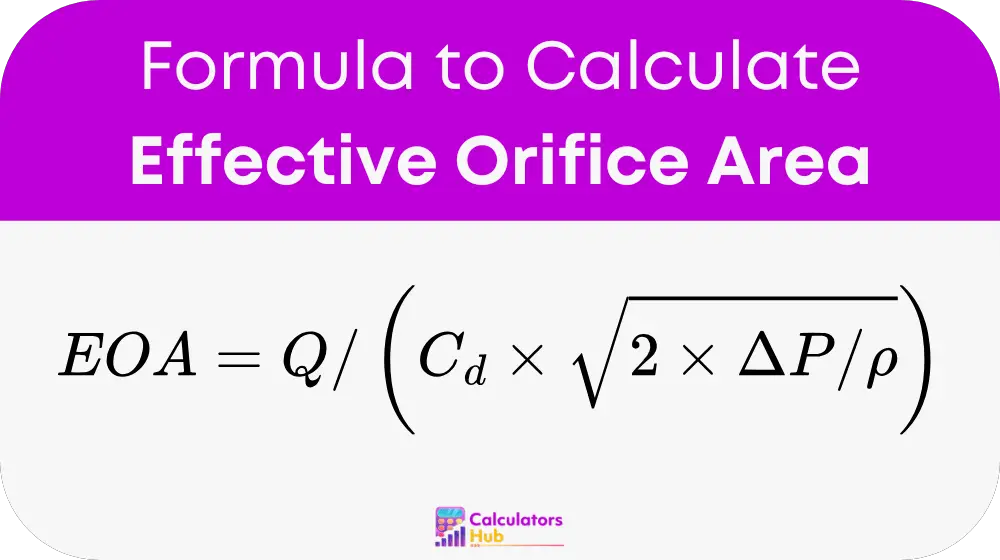Effective Orifice Area Calculator is an essential tool used in fluid dynamics and engineering to estimate the area of an orifice through which fluid flows, accounting for losses due to turbulence and flow inefficiencies. This calculation is critical for designing systems that control or measure the flow of fluids, such as pipes, valves, and nozzles.
The effective orifice area (EOA) represents the flow capacity of an orifice, adjusted for factors like the discharge coefficient and pressure drop. It is widely used in applications involving water treatment, HVAC systems, hydraulic machinery, and fluid measurement devices.
Questa calcolatrice rientra nella Fluid Dynamics and Engineering Calculators category, offering practical solutions for engineers, designers, and researchers looking to optimize fluid systems.
Formula of Effective Orifice Area Calculator

variabili:
- EOA:
Effective Orifice Area — the actual area available for fluid flow, accounting for losses, in square meters (m²) or pollici quadrati (pollici²). - Q:
Flow Rate — the volume of fluid passing through the orifice per unit tempo, in cubic metri al secondo (m³/s) o piedi cubi al secondo (ft³/s). - C_d:
Discharge Coefficient — a dimensionless factor that accounts for inefficiencies in the flow through the orifice. It typically ranges from 0.6 to 0.8 for sharp-edged orifices. - ΔP:
Pressure Drop — the difference in pressure across the orifice, measured in Pascals (Pa) or pounds per square inch (psi). - ρ:
Fluid Density — the mass per unit volume of the fluid, measured in kilograms per cubic meter (kg/m³) or pounds per cubic foot (lb/ft³). - sqrt:
Radice quadrata function — used to calculate the denominator.
Fasi di calcolo:
- Measure or obtain the Flow Rate (Q):
The flow rate is usually measured using a flowmeter or calculated based on system specifications. - Determine the Pressure Drop (ΔP):
Use a manometer or pressure sensors to measure the pressure difference across the orifice. - Identify the Fluid Density (ρ):
Depending on the fluid type (e.g., water, oil), determine the density at the current temperature and pressure. - Obtain the Discharge Coefficient (C_d):
For standard orifices, C_d is typically around 0.61, but this value can vary depending on the orifice shape and flow conditions. - Compute the denominator:
Calculate the term C_d * sqrt(2 * ΔP / ρ). - Calculate EOA:
Finally, compute the effective orifice area using the formula:
EOA = Q / (computed denominator).
This will give you the effective area through which fluid flows, adjusted for the flow dynamics of the system.
Reference Table: Unit Conversions and Common Values
The table below helps to convert common units and provides typical values used in fluid flow calculations.
| Parametro | Unità SI | Unità Imperiale | Example Value (Water at 20°C) |
|---|---|---|---|
| Portata (Q) | m³ / s | piedi³/s | 0.1 m³/s = 3.53 ft³/s |
| Coefficiente di scarico (C_d) | Senza dimensione | Senza dimensione | 0.61 for standard orifice |
| Caduta di pressione (ΔP) | Pa | psi | 500 Pa = 0.0725 psi |
| Densità del fluido (ρ) | kg / mc | libbre/piedi³ | 1000 kg/m³ = 62.4 libbre/piede³ |
Example of Effective Orifice Area Calculator
Scenario:
Consider a pipe with a flow rate of 0.1 m³/s, a pressure drop across the orifice of 500 Pa, and water as the fluid (density = 1000 kg/m³). Assume the discharge coefficient (C_d) for the orifice is 0.61.
Step 1: Obtain Values
- Q = 0.1 m³/s
- ΔP = 500 Pa
- ρ = 1000 kg/m³
- C_d = 0.61
Step 2: Calculate the denominator
Denominator = C_d * sqrt(2 * ΔP / ρ)
= 0.61 * sqrt(2 * 500 / 1000)
= 0.61 * sqrt(1) = 0.61
Step 3: Calculate EOA
EOA = Q / Denominator
EOA = 0.1 / 0.61 ≈ 0.164 m²
Risultato:
The effective orifice area is approximately 0.164 m², which means the area through which fluid flows, accounting for pressure loss and inefficiencies, is 0.164 square meters.
Domande frequenti più comuni
A: The discharge coefficient accounts for the inefficiencies in fluid flow through the orifice. It depends on factors like the shape of the orifice, the Numero di Reynolds, and the flow regime. For sharp-edged orifices, C_d is typically around 0.61, but it can be higher or lower for different conditions.
A: The pressure drop across an orifice represents the energy lost due to friction and turbulence. This loss reduces the actual flow capacity, which is why the pressure drop must be included in the calculation of the effective orifice area.
A: If the actual orifice area is significantly different from the calculated effective orifice area, this may indicate inefficiencies or issues with the orifice design, such as rough edges, improper installation, or blockage.